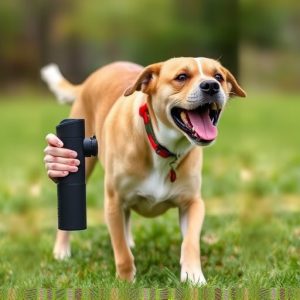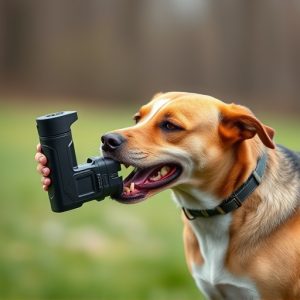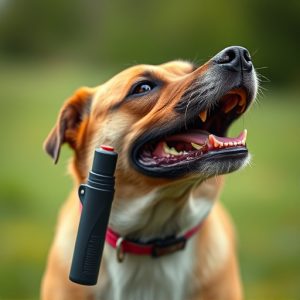Legal Use of Pepper Spray for Dog Control: Techniques and Regional Guidelines
TL;DR:Pepper spray tailored for dog control, known as oleoresin capsicum (OC), temporarily disorient…….
TL;DR:
Pepper spray tailored for dog control, known as oleoresin capsicum (OC), temporarily disorients dogs by irritating their eyes, nose, and respiratory system. Formulations include OC, various pepper compounds, and safety-enhancing ingredients. Legal parameters vary across regions, classifying it as a less-lethal tool with strict regulations on possession, deployment, and user certification to ensure humane and effective use while minimizing risks to animals and humans. Strategic application focuses on the face and muzzle, aiming to subdue aggressive dogs without lasting harm after exhausting other methods.
“Unleashing control with a pepper spray formulation has emerged as a strategic tool in managing aggressive dogs. This article delves into the intricate world of dog control, focusing on the legal framework surrounding the use of pepper spray and its effectiveness against canine aggression. We explore regional variations in regulations, shedding light on when it’s legally permissible to utilize this method. Furthermore, we provide practical application techniques, offering insights to maximize the impact and ensure safety during interactions with aggressive dogs.”
- Understanding Pepper Spray Formulation for Dog Control: Legal Framework and Safety Measures
- When Is It Legal to Use Pepper Spray Against Aggressive Dogs? Exploring Regional Variations
- Effective Application Techniques: Maximizing the Impact of Pepper Spray on Aggressive Canine Behavior
Understanding Pepper Spray Formulation for Dog Control: Legal Framework and Safety Measures
Understanding Pepper Spray Formulation for Dog Control involves grasping both its chemical composition and the legal parameters surrounding its use. Pepper spray, also known as oleoresin capsicum (OC), is derived from chili peppers and works by irritating the eyes, nose, and respiratory system of dogs, temporarily disorienting them. The formulation typically includes OC, a variety of pepper compounds, and other ingredients designed to enhance efficacy and safety.
The legal framework for using pepper spray against aggressive dogs varies significantly across regions. In many areas, it is classified as a less-lethal tool for animal control, subject to strict regulations regarding who can possess, carry, and deploy it. Safety measures are paramount; users must be properly trained and certified, and the spray must be stored securely to prevent unauthorized access. Adherence to these guidelines ensures that pepper spray is employed humanely and effectively while mitigating risks to both animals and individuals.
When Is It Legal to Use Pepper Spray Against Aggressive Dogs? Exploring Regional Variations
Using pepper spray against aggressive dogs is a controversial topic, with laws varying widely across regions. In general, it’s only legal to use pepper spray as a last resort when other de-escalation methods have failed and the dog poses an imminent threat of serious harm. The specific regulations differ significantly from place to place, so understanding local laws is crucial.
In many jurisdictions, pepper spray formulations designed specifically for animal control must meet certain criteria, such as reduced toxicity levels compared to standard police-grade sprays. These restrictions aim to protect both the dog and bystanders while ensuring the spray’s effectiveness in calming aggressive canines. Always check your area’s specific regulations regarding the use of pepper spray against dogs, keeping in mind that responsible usage requires proper training and a deep understanding of canine behavior.
Effective Application Techniques: Maximizing the Impact of Pepper Spray on Aggressive Canine Behavior
The effective application of pepper spray against aggressive dogs requires a strategic approach, considering the unique formulation and its impact on canine behavior. When using pepper spray as a last resort, it’s crucial to target specific areas that can quickly subdue an enraged dog without causing long-term harm. The spray’s formula varies, designed to irritate the eyes, nose, and respiratory system of the animal, but understanding how to deploy it accurately is key.
For maximum impact, aim for the face and muzzle, as these areas are highly sensitive. A swift and precise application can temporarily disable a dog, allowing handlers to gain control. It’s important to note that pepper spray should only be used when other methods of training or behavior modification have been exhausted. The right formulation, combined with proper application techniques, ensures its effectiveness in de-escalating aggressive canine encounters while prioritizing the safety of both animals and people involved.
The legal and safe application of pepper spray formulation against aggressive dogs involves understanding both regional laws and effective application techniques. By knowing when and how to deploy this tool, individuals can enhance their ability to protect themselves and others from potential dog attacks. It’s crucial to stay informed about local regulations and prioritize safety measures when considering the use of pepper spray as a last resort for canine behavior management.


